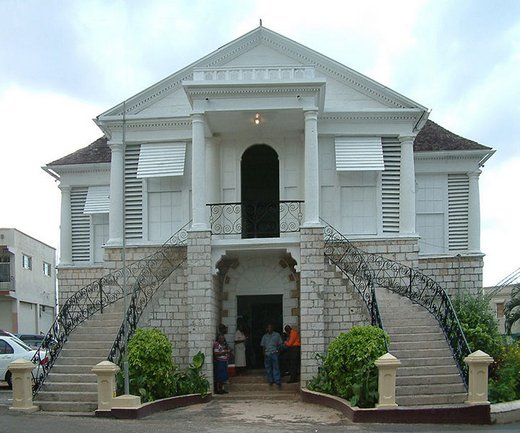 |
The town stands at an altitude of 628 m (2061 feet) towering over the Don Figuerero Mountains; thus, it is said to be the coolest of town in Jamaica. The uniqueness of the tropical paradise is even more historic as it is the only capital city in Jamaica that is not near the sea coast or any major river.
Mandeville’s population, in 2005, was believed to be between 50,000 and 72,000 people. It comprises many intellectuals and returning residents from America, mainly from England; so much so that it was sometimes called the "English Town" .
Its growth was spurred by the establishing of an alumina mining company, Alcan Bauxite in partnership with the Jamaican government in 1957. Its high wages, housing, and other attractive benefits lured educated Jamaicans and returning residents to the peaceful and serene town. This environment was ideal for young professionals and upper income households to build luxurious, extravagant and conspicuous houses- and many did!
Location
This town is located in the centre of Jamaica. Its transportation centre connects the curious traveler to any point in Jamaica – directly or indirectly. Particularly, it is a gateway to other resorts areas along the South Coast which boasts booming activities in eco and community tourism.
Many of the oldest businesses within the Caribbean were started in this town! The Manchester Golf Club of 1868 was the Caribbean’s first golf course; One of our first hotels in the Caribbean, the Mandeville Hotel, began there in 1875; and the oldest parish library in Jamaica and also the first free library was established in Mandeville in 1938.
It is also a growing education centre. This is evidenced by the presence the Northern Caribbean University, one of the best universities in the Caribbean.
Many of the original buildings are still visible in the town-centre.
The town is mostly build around the Cecil Carlton Park. At the northern end at the park stands the Mandeville Courthouse. Built in 1816, it boasts genuine cut-lime stones and towers up to a two story-double stair cased design. Adjacent to this is the Rectory, which is believed to be the oldest dwelling structure in Mandeville. It was completed in 1820.
The St. Mark’s Church lies to the south side of the square which was also established in 1820. The graveyard of this church is the final resting place of many British soldiers who died of the dreadful yellow fever many many years ago.
Attractions
Outside of it's scenery and tranquility, Mandeville is not known for many hot attractions- and don't be surprised, it is more residential. However they still hosts quite a few sites that will appease the adventurous.
These include:
- Mrs. Stephenson’s Garden – one of the most beautiful and well-maintained in Jamaica at 25 New Green Rd.
- The Manchester Country Club – an 18-hole golf course on bromalia road.
- The Jamaican Standard Products Company – offers free tours of coffee fields, reaping, preparing, packaging & tasting.
- The Mandeville Hotel – for elegant dining and beautiful accommodation with delightfully pleasant ambiance
diGBlog »
Manchester
Area
830 Km²
830 Km²

Population
191,378
Name Origin
Established in 1814 and named for the Duke of Manchester who was then Governor of Jamaica
Manchester is a mountainous parish. Over 90% of the parish's surface is limestone so there is an abundance of cockpits, sinkholes, caves and underground passages. The Oxford Cave in upper Manchester is the largest of the known caves in the parish. Because of the limestone, most of the rivers flow underground like the Alligator Hole River, Alligator Pond River, Crambie River, Gut River, Hector's River, Two Rivers and Swift River. Hector's River flows along the borders of Manchester and Trelawny, disappears underground at Troy and rises below Oxford Cave as the One Eye River.
Almost all of the parish is between 2000 and 300 feet above sea level. The main mountain ranges are the Carpenters, May Day and Don Figuerero Mountains. The high elevation and cool climate of Manchester make it favoured place for Jamaican returning home after living abroad.
Agriculture, bauxite mining and processing, small scale manufacturing and livestock rearing are the main economic activities in Manchester. The major towns are the capital, Mandeville, Christiana, Devon, Mile Gully, Newport, Porus, Williamsfield


 Play diGTrivia
Play diGTrivia